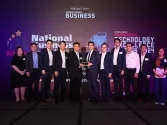Data Maturity & Innovation Key to Industry Leadership in Today’s Business Landscape

Splunk’s Dhiraj Goklani, Vice President of Observability for APAC, said that data volume and innovation have been exploding since 2020, helping organisations thrive through the global pandemic and beyond.
Today, as a result of better and more complex use of data, businesses have improved their customers’ digital experience, streamlined disruptions to supply chains and service models, enhanced security positions, and, overall, grown their businesses.
Splunk, a software provider whose platform bridges data and action to empower observability, IT and security teams to ensure their organisations are secure, resilient, and innovative, has released a report titled “The Economic Impact of Data Innovation 2023,” where it revealed that organisations that invested heavily in data and developed a mature data approach are reaping the rewards, including:
- Higher customer satisfaction (36% of leaders versus 21% of beginners)
- Entry into new markets (33% versus 16%)
- Engagement of customers in new channels (30% versus 16%)
- Increased customer wallet share (32% versus 13%)
- Improved customer retention (35% versus 18%)
- Better brand standing (35% versus 17%)
Further citing the survey results, Dhiraj Goklani, Vice President, Observability at Splunk APAC region, revealed that the leaders “overshoot their earnings targets at twice the rate of beginner-level businesses.”
“Across our survey, all three maturity cohorts tended to exceed their earnings targets, but leading organisations averaged +7.79%, whilst beginners clocked +3.94%. Leaders operationalise a higher percentage of their data: 66% of all the data that their organisations produce, versus 48% amongst beginners and 57% amongst intermediates,” he detailed.
Singapore, specifically, “has seen an explosive growth in fintech companies such as payment and cryptocurrency trading platforms,” said Dhiraj. “This is challenging the financial services sector, including traditional banks, to drive more digital transformation to stay competitive.”

8 Strategies that Drive Data Innovation
Businesses not only need 360-degree visibility of their data but also to be empowered to act upon their data promptly. But this is no easy feat, as organisations grapple with challenges to data maturity and innovation as a result of “limited support from IT leadership and business lines, together with a lack of organisational structure and processes, possibly due to a skills shortage,” according to Dhiraj.
Dhiraj, who has 24 years of experience in leadership, strategy, product management, people management, sales, and relationship management under his belt, added that "siloed data environments, limited visibility, reactive vs. proactive & predictive, and the inability to showcase and evangelise value tied to critical business initiatives” are hindering organisations’ progress toward data maturity.
Amongst the industries in the region, “the healthcare and manufacturing sectors are struggling to operationalise their data given higher privacy and data regulatory requirements, slower adoption of cloud technologies, and higher technical debt from legacy platforms,” he said. Meanwhile, “the leading sectors are financial services, technology, and retail.”
To achieve data maturity and innovation, Splunk recommends business leaders to apply these eight key strategies:
1. Prioritise data innovation.
Leaders take data seriously. According to the report, 60% say better uncovering and using their data is the single most important business and IT priority for the next 24 months, compared with 34% of intermediates and 13% of beginners.
This commitment to data innovation encompasses a data-driven strategy, keeping leaders updated, tracking progress, and measuring performance against data innovation goals.
2. Invest for success.
Leaders allot 53% more of their technology budgets for solutions and staff for data investigation, monitoring, and analysis compared with beginners. Further, 92% of leaders emphasise a platform strategy, use technologies that work across silos, incorporate multiple sources, and operate on-premises and on the cloud.
Finally, leaders adopt new technologies, such as cloud analytics, that support their data innovation efforts. AI/ML, edge computing, observability, and machine learning are in different phases of adoption, but gaining traction.
3. Bring innovation to the executive level.
More than 90% of leaders have C-level roles around customer success, data governance, data strategy, and innovation, making space for innovative thinking at the highest levels of the organisation.
Leaders, however, revealed that their data innovation goals made the search for talent challenging in the areas of data cleaning and prep, AI/ML, and data visualisation.
4. Establish a centre of excellence.
About 57% of leaders say they “always” rely on centres of excellence (CoE) to advance data initiatives with centralised teams, compared to 33% of intermediates and 15% of beginners. The gap narrows when you look at leaders who “always or usually” use a CoE: 76% of leaders, 63% of intermediates, and 60% of beginners.
5. Prioritise tech-centric data streams today.
Interestingly, leaders were more apt to cite tech-oriented data when asked which sources had most fueled their innovation recently. Leaders’ top three sources for innovation were network, application, and business service transaction/performance data. Conversely, beginners put customer and sales data first.
6. Pivot to “know your customer” data next.
Leaders recognise that certain types of data could further drive innovations, such as sales data (25%), and customer data (23%), with business service transaction and performance data (31%) having the most potential. To eventually leverage these more human-centric data, leaders say they are currently focused on building the infrastructure.
7. Commit to either speed or success.
Leaders favour either innovating at top speed or applying well-researched market suitability instead of balancing these two approaches, as beginners and intermediates would. They believe that it is better to excel at something than to be average at everything.
8. Cultivate a broader sense of paranoia.
Rather than resting on their laurels, leaders keep an eye on more competitive threats, such as the sudden emergence of enterprise-class competition and startups. But 75% of them are also confident that data will be used to further streamline organisational functions, versus 69% of intermediates and 63% of beginners. They also believe that new uses for data keep them competitive in emerging or future industries.
Driving Data Innovation Further
To reinforce data innovation amongst Singapore businesses, Dhiraj recommends that companies “Learn from the leaders, ideally in their own industry, on the strategies that worked and can be implemented in their organisations.”
He added that this can be combined with “benchmarking their current state of data innovation and finding inefficiencies to address in the near term” and “reducing complexity and cost by removing data silos and consolidating data platforms such as across IT and Security.”
With people being a key component in data innovation success, Dhiraj in closing said that businesses must “build awareness and evangelise the value of data insights to senior leadership to drive change and create a shared data centre of excellence and align resources to critical business initiatives.”



![SBR 5 Lorem Ipsum News 2 [8 May]](https://cmg-qa.s3.ap-southeast-1.amazonaws.com/s3fs-public/styles/exclusive_featured_article/public/2025-05/a_hand_pointing_to_a_futuristic_technology_5b87c9d0e3_3.png.webp?itok=M3Hf-9XR)
![SBR 4 Lorem Ipsum [8 May Top Stories]](https://cmg-qa.s3.ap-southeast-1.amazonaws.com/s3fs-public/styles/exclusive_featured_article/public/2025-05/a_hand_pointing_to_a_futuristic_technology_5b87c9d0e3_2.png.webp?itok=2m5Wl0MX)


![Exclusive three SBR 12 Lorem Ipsum [8 May]](https://cmg-qa.s3.ap-southeast-1.amazonaws.com/s3fs-public/styles/exclusive_featured_article/public/2025-05/a_hand_pointing_to_a_futuristic_technology_5b87c9d0e3_11.png.webp?itok=8kn_UIfA)
![SBR 3 Lorem Ipsum [ Exclusive 2]](https://cmg-qa.s3.ap-southeast-1.amazonaws.com/s3fs-public/styles/exclusive_featured_article/public/2025-05/a_hand_pointing_to_a_futuristic_technology_5b87c9d0e3_1.png.webp?itok=YCyjLegJ)
![SBR 2 Lorem Ipsum [8 May]](https://cmg-qa.s3.ap-southeast-1.amazonaws.com/s3fs-public/styles/exclusive_featured_article/public/2025-05/a_hand_pointing_to_a_futuristic_technology_5b87c9d0e3_0.png.webp?itok=_cKD-29o)

![Video [Event News]](https://cmg-qa.s3.ap-southeast-1.amazonaws.com/s3fs-public/styles/event_news_featured_article/public/2025-05/screenshot-2025-05-08-at-4.58.53-pm_0.png.webp?itok=Kud35sMs)
![Event News SBR 9 Lorem Ipsum [8 may]](https://cmg-qa.s3.ap-southeast-1.amazonaws.com/s3fs-public/styles/event_news_thumbnail/public/2025-05/a_hand_pointing_to_a_futuristic_technology_5b87c9d0e3_8.png.webp?itok=DTh_dbYp)
![Event News SBR 9 Lorem Ipsum [8 May]](https://cmg-qa.s3.ap-southeast-1.amazonaws.com/s3fs-public/styles/event_news_thumbnail/public/2025-05/a_hand_pointing_to_a_futuristic_technology_5b87c9d0e3_7.png.webp?itok=vzDAzb6V)
![Event News SBR 8 Lorem Ipsum [8 May]](https://cmg-qa.s3.ap-southeast-1.amazonaws.com/s3fs-public/styles/event_news_thumbnail/public/2025-05/a_hand_pointing_to_a_futuristic_technology_5b87c9d0e3_6.png.webp?itok=jvHFc4P6)
![Video [Event News]](https://cmg-qa.s3.ap-southeast-1.amazonaws.com/s3fs-public/styles/video_thumbnail/public/2025-05/screenshot-2025-05-08-at-4.58.53-pm_0.png.webp?itok=yZnI0YBb)
![Video 1 SBR [8 May]](https://cmg-qa.s3.ap-southeast-1.amazonaws.com/s3fs-public/styles/video_thumbnail/public/2025-05/screenshot-2025-05-08-at-4.58.53-pm.png.webp?itok=9AAeRz_k)

 Advertise
Advertise

